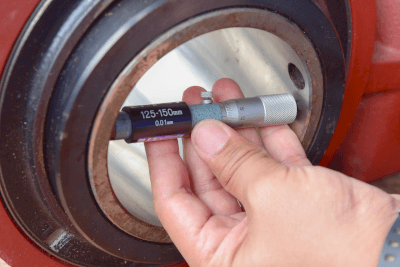What Is an Inside Diameter Gauge?

An inside diameter gauge is a versatile device used for measuring the internal diameter of a cylinder or hole.
Many products feature holes for mounting or tubes for wiring. Inside diameter gauges are employed to accurately measure their size and dimensions. While devices like calipers and micrometers can measure inside diameters, a tool specifically designed for this purpose is referred to as a “hole test.”
An accurate reading can be obtained by adjusting the thickness with a dial and matching it to the inside diameter. Measurements can be made with precision down to several micrometers. There are two types available: an “analog type” that visually displays the value and a “digital type” that calculates the value automatically.
Uses of Inside Diameter Gauges
Inside diameter gauges find applications in a wide range of situations, particularly in measuring the inside diameter of products manufactured or processed in factories. The manufacturing process often requires holes of various sizes for connecting parts and routing wiring.
Accurate measurements are crucial because even slight variations in hole sizes can lead to connection problems, malfunctions, or defects. Hole tests excel at providing precise measurements with an accuracy of a few micrometers, making them suitable for rapid measurement of hole and tube inside diameters. They are also valuable for accurately measuring threaded holes to ensure strong connections and enhance safety.
Principles of Inside Diameter Gauges
Numerous devices are available for measuring inside diameters. We will explain the structure and features of the Hole Test as an example.
The Hole Test is an instrument used to measure inside diameter by inserting it into a hole and employing two or three measuring elements. As the dial is turned, the measuring elements gradually expand and stop when they contact the inside of the hole. By measuring this position, the inside diameter can be determined. The advantages of the Hole Test include:
- Highly accurate measurements that are relatively easy to obtain.
- Consistent measurements with minimal variation.
- Stable measurements, especially for larger inside diameters (greater than a specific size), due to measurements at three points.
However, there are also disadvantages, such as:
- High cost.
- Calibration requirements.
- A limited measurement range, necessitating multiple units for various needs.
The Hole Test is a sensitive device with a higher price point. It requires calibration before measurement, which can be time-consuming. Furthermore, it has limitations on the types and sizes of holes it can measure, often necessitating the use of multiple Hole Tests depending on the application.
Types of Inside Diameter Gauges
Inside diameter gauges can be broadly classified into three types: Hole Test / Borematic, Inside Micrometer, and Cylinder Gauge.
- Hole Test / Borematic
The Hole Test / Borematic, also known as an inside micrometer or 3-point micrometer, measures the inside diameter by contacting it at three points. For smaller bores (6 mm or less), a two-point contact is used due to structural limitations. Some digital models of borematics are referred to as ABS borematics, as they do not require origin adjustment each time the power is turned on.
- Inside Micrometer
An inside micrometer measures the inside diameter by touching both ends of the diameter. It measures only the length of the diameter. By adding rods, it is possible to measure larger bore diameters. However, since two points are in contact, care must be taken to prevent measuring point misalignment, especially in deep bores. Measurement must be perpendicular to the bore’s center axis.
- Cylinder Gauge
Similar to the inside micrometer, the cylinder gauge measures at two points. It is suitable for measuring small holes where the main body of the instrument cannot enter the hole. Only the measuring element enters the hole, and the dial and other parts displaying the measured value can be read outside the hole. These inside diameter gauges are ideal for measuring small and deep holes.